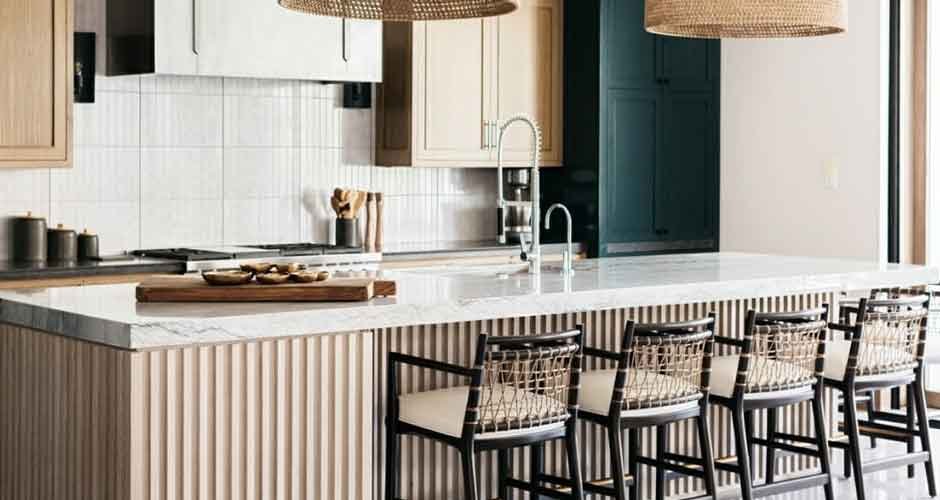If you’re in the restaurant business, keeping your kitchen up-to-date isn’t just about staying trendy; it’s about making smart, strategic moves to enhance efficiency, safety, and the overall dining experience.
As we head into 2024, several key trends are shaping up to define the commercial kitchen landscape. Whether you’re thinking of opening a new restaurant or considering a makeover for your existing space, here are the top kitchen design trends to keep an eye on.
Open and Inviting Kitchen Layouts
Gone are the days when kitchen activities were hidden behind closed doors. More restaurants are embracing open kitchen designs that allow guests to view the magic as it happens. This transparency not only entertains guests but also builds trust by showcasing the cleanliness and professionalism of your operations.
For chefs, the interaction with guests adds a new layer of engagement to their job, which can be incredibly fulfilling.
Multi-Functional Spaces
Space efficiency has never been more critical, especially in urban areas where square footage comes at a premium. The trend towards multi-functional kitchen spaces is about creating areas that can easily transition between different uses.
Think of a countertop that serves as a prep area, a serving station, and a bar at different times of the day. This adaptability not only maximizes the use of space but also reduces overhead costs.
Sustainability at the Forefront
As consumer awareness of environmental issues grows, restaurants are increasingly expected to step up their green game. This extends into the kitchen, where sustainable practices are becoming a priority. From energy-efficient appliances to waste reduction systems, every element is designed to minimize environmental impact.
Opting for eco-friendly commercial kitchen supplies, like those from Tarrison, which are known for their durability and energy efficiency, can help reduce your carbon footprint while keeping operational costs in check.
Safety-Driven Designs
In the wake of heightened health awareness, safety-driven designs have become a cornerstone of modern kitchen planning. The choice of layout and materials is critical in maintaining top-notch hygiene standards. Kitchens are increasingly being fitted with non-porous surfaces like stainless steel, which are not only easier to sanitize but also resist bacteria and mold growth. Floors that resist slips and are simple to clean without harsh chemicals are also essential.
Moreover, the integration of touchless technology, such as faucets and soap dispensers, helps to minimize contact points and reduce the spread of germs. Advanced ventilation systems are another key feature, improving air quality and removing airborne contaminants effectively.
Designers are also thoughtful about the kitchen’s workflow, arranging spaces to allow for ample social distancing while ensuring that the culinary team can operate efficiently and cohesively without constant physical interaction.
Smart Technology Integration
Technology continues to make significant inroads into the restaurant industry, and kitchen design is no exception. Smart appliances that can be controlled via smartphone or voice are becoming commonplace.
These devices help streamline cooking processes, ensure precision in recipes, and can even monitor energy use for better efficiency. Installing smart ovens, fridges, and HVAC systems can lead to significant savings over time, not to mention the convenience they bring.
Bold and Personalized Aesthetics
A kitchen’s design should be as distinctive as the culinary experiences it aims to create. While practicality is paramount, the aesthetics of a kitchen significantly contribute to the dining atmosphere, making it a critical element in customer satisfaction. The latest trends are veering away from the sterile, industrial look to embrace bold, expressive designs that feature bright colors, bespoke fixtures, and unique decorative accents.
Customization is at the heart of this trend, with restaurants opting for tailor-made solutions that reflect their brand and ethos. For instance, a Mediterranean restaurant might choose azure tiles and terracotta accents to evoke the feel of a seaside villa, while a modern bistro might opt for sleek black surfaces and chrome finishes for a more urban vibe.
Ergonomic Design for Staff Well-being
Ergonomics is about more than just comfort—it’s about creating environments that promote health and productivity. In the fast-paced world of culinary service, where staff spend long hours on their feet, the importance of an ergonomically sound kitchen design cannot be overstated. This involves the strategic placement of equipment and supplies so that they are within easy reach and at the correct heights to prevent strain.
Adjustable-height counters are a boon, catering to staff of varying heights and making prep work less physically taxing. Anti-fatigue mats can also be placed in areas where staff might stand for prolonged periods, offering cushioning that reduces the impact on joints and back. The overall layout is planned to minimize unnecessary movements, conserving energy and speeding up service delivery.
Wrapping Up
Revamping your restaurant’s kitchen isn’t just about following trends; it’s about making thoughtful choices that enhance your operational efficiency, reduce costs, and improve the dining experience.
By embracing these trends, you can ensure your kitchen is modern and a dynamic part of your restaurant’s success. Remember, a well-designed kitchen is the heart of your restaurant, pumping out not just meals but also the energy and passion of those who work there.
Make it a place where both form and function are in perfect harmony, and you’ll see the difference in every plate that leaves it.



